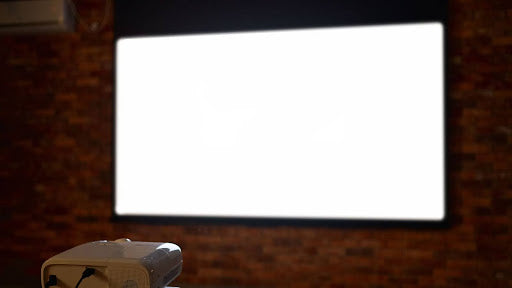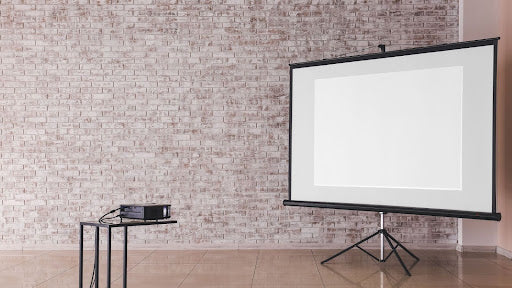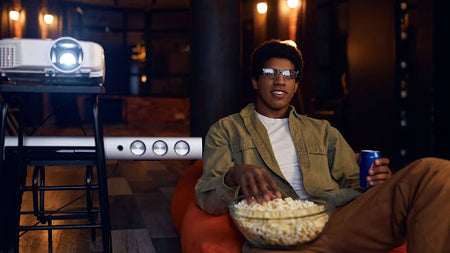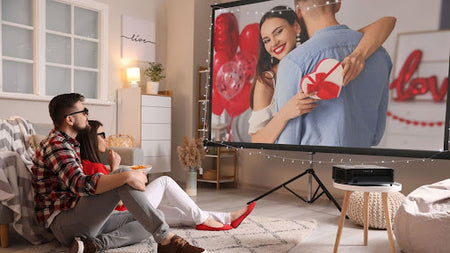Selecting the right projector for your home or outdoor use involves a myriad of considerations, with the throw ratio standing out as one of the most crucial elements. Contrary to common belief, a spacious room isn't always a prerequisite for projecting larger images. The throw ratio determines the quality and dimensions of the projected image.
Dive into our comprehensive guide on projector throw ratios to unlock the secrets of leveraging this key feature to achieve superior image quality from your projector.
What Is Projector Throw Ratio?
The projector throw ratio determines how far you need to place your projector from the screen to achieve the desired image size. It's crucial to get this right to ensure that your projector fits the dimensions of your room and delivers the best viewing experience.
For example, a projector with a throw ratio of 2:1 means that for every 2 feet of distance from the screen. The projector will produce 1 foot of image width. So, if you aim for a 6-foot wide image, the projector must be 12 feet away from the screen.
Whether you're setting up a home theater, a classroom, or a conference room, understanding the concept of throw ratio is key to achieving a clear, proportionate, and well-positioned display.
Long Throw Vs. Short Throw Projectors
Understanding the differences between long-throw and short-throw projectors is crucial in selecting the right one for your needs based on spatial requirements and usage scenarios.
Long-throw projectors, such as the WeWatch V10 Pro, are specifically designed to display large images from a significant distance, usually from the back of a room. They are perfect for large conference rooms or home theaters where space is not limited.
The advantage of long-throw projectors is their versatility in projecting large, clear images without casting shadows or causing obstructions. However, their need for ample space can be a limitation in smaller environments.
Short-throw projectors require less distance to project large images, making them ideal for small spaces like classrooms or living rooms. They can be placed just a few feet away from the screen, minimizing shadows and glare caused by people walking in front of the projector. This makes short-throw projectors particularly advantageous for interactive presentations or environments where space is premium.
How to Calculate Projector Throw Distance

Calculating the throw ratio (TR) is relatively easy. You simply divide the projector's throw distance (TD) by the image width (IW). The equation is written as follows:
| TR = TD / IW |
You can use this equation in many situations. For example, if you know a projector's throw ratio, you can figure out how far away it will need to be installed to get a certain image width. If you know the size of your room, you can figure out the ideal throw ratio for your desired image size.
What Is the Best Viewing Distance for a Projector?
Determining the best viewing distance for a projector depends on the size of the projected image and the viewer's visual acuity, which is usually based on the concept of "optimal viewing distance." The SMPTE (Society of Motion Picture and Television Engineers) recommends a distance range of 1.5 to 2.5 times the screen's diagonal size as the ideal viewing distance. For example, the optimal viewing distance for a 100-inch diagonal screen would be between 150 inches (about 12.5 feet) and 250 inches (about 20.8 feet).
This range ensures that viewers can comfortably see the entire image without moving their heads too much while maintaining satisfactory detail and immersion. If the viewer sits closer than this range, the pixel structure may become visible, particularly when using lower-resolution projectors, which can lead to visual discomfort. On the other hand, sitting farther away from the screen may reduce the immersive experience and make it harder to see fine details.
The projector's resolution should also be considered when determining the ideal viewing distance. Higher resolution projectors, such as 4K, can generally be viewed from closer distances because the pixel density is higher, making individual pixels less noticeable. Additionally, the type of content being viewed and personal preferences can influence the ideal viewing distance.
For cinematic experiences, a distance closer to the lower end of the range may be more immersive. In contrast, a slightly farther distance might be preferable for presentations or educational content to comfortably encompass the entire field of view.
How to Use Throw Ratio to Set up Your Projector
Understanding and applying the throw ratio when choosing and positioning your projector correctly is crucial. For instance, if you aim for a six-foot-wide image and have a projector with a throw ratio of 1.4, you must position the projector approximately 8.4 feet away from the screen. This is calculated using the formula:
|
Throw Distance=Throw Ratio×Image Width 1.4=Throw Distance/6 Throw Distance=1.4×6=8.4 feet |
Conversely, if you know your projector's setup distance and desire a specific image width, you can reverse-engineer the appropriate throw ratio. For example, if your available space allows for a projector placement nine feet from the screen and you want a seven-foot-wide image, the suitable throw ratio would be approximately 1.3:
|
Throw Ratio=Throw Distance/Image Width Throw Ratio=9/7≈1.3 |
Conclusion
By mastering these concepts, users can effectively avoid common pitfalls such as image distortion, improper sizing, and reduced image quality, ensuring the projected content is displayed clearly and proportionately. WeWatch offers a variety of projectors and accessories to meet your needs. Check out our range of projectors here.



